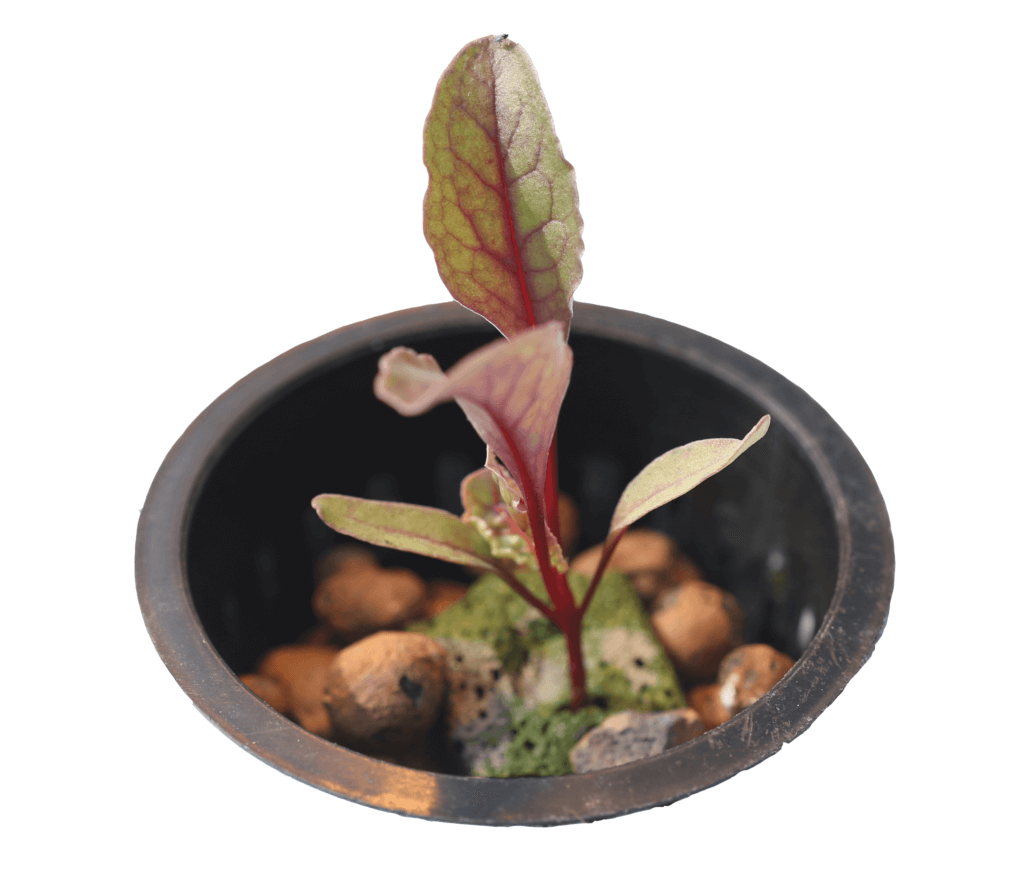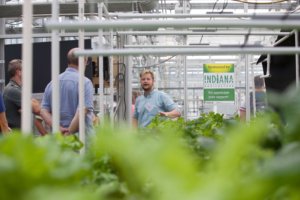Technology distilled to grow the hydroponics industry

When Horticulture Assistant Professor Krishna Nemali joined Purdue in July 2016, he immediately began to develop a program as new to the school as he was. Nemali studied agriculture in India before earning his Ph.D. from the University of Georgia and spending nine years as a scientist in controlled environment crop physiology at Monsanto. All these experiences combined to provide him with the range of experience necessary in his current position coordinating research and Purdue Extension activities in Controlled Environment Agriculture (CEA).
CEA harnesses technology to grow plants like vegetables and ornamentals in conditions that maximize the efficient use of water, light, labor, and space. Hydroponics, the method most commonly associated with CEA, minimizes water, nutrient, and labor requirements to grow plants. It can also reduce other needs, such as pesticides. Researchers like Nemali work to discover the perfect combinations of water, light, nutrients, temperature, and additional factors to make sure there is no wasted energy or potential. Nemali’s goal is to answer the question,
“How do you make that technology easily accessible to everybody?”
Nemali is working to harness the potential of smartphones, specifically, new apps and add-on devices, to provide growers access to these processes. “There are companies and some apps already there that just take a picture and show some data. That’s not what we’re trying to get at. We have these expensive imaging stations and we are developing technologies that match that high-quality data.” A combination of research, calibration and algorithms takes place behind the scenes to provide farmers with valuable, yet easy-to-understand information, everything using their smartphones.

One app Nemali is creating will use background processing to measure plant growth. The plant’s size is calculated through pictures the user takes and algorithms designed by Nemali. With daily use, the app generates growth curves. “It’s like when you take your kids to a doctor, and they take a weight and height measurement. They put the numbers on a standard chart. 90th percentile height, 70th percentile weight. You can create standard curves for different species and plot this data under the standards.”
Image block
Nitrogen is essential in plant processes, including photosynthesis, yet the equipment needed to measure nitrogen levels in plants is cost-prohibitive. Nemali’s lab is currently creating a similar device for smartphones, available for less than $150. Nemali hopes to create widely adopted and applied technology to reach independent growers.
Through Purdue Extension, Nemali also works with Indiana farmers to capitalize on the untapped potential hydroponics provides. The industry is small, but rapidly growing at 3.5% annually in the US. For example, Nemali sees a wealth of opportunity in leaf lettuce production. The USDA estimates people eat about 11 pounds of leaf lettuce per year. With 6.7 million Hoosiers and a $1.00 wholesale valuation on each pound of lettuce, that’s over $70 million.
Indiana imports nearly all its leaf lettuce from places like Arizona and California. “We want that money to stay within Indiana," Nemali shared. We want our growers to capitalize on this. There is a demand there. Grow lettuce locally, sell lettuce locally, and keep the money local. That money spread out among the 300 lettuce growers in Indiana, that’s going to improve their livelihood. That’s what sustainability, in my opinion, is.” He organizes workshops that provide both classroom-style training and experiential learning to farmers.
The methods and technology Nemali creates produce a level of precision that can set hydroponic farmers apart. Even small adjustments to the levels of red, green, and blue artificial light provided to grow plants can have significant effects on the growth, color, and nutritional value of plants. Nemali tells his growers, “Don’t say simply that your lettuce is crisp and fresh. Everybody says that. How do you find a niche? Use technology to grow lettuce that has more nutritional value, antioxidants, and less nitrates. Show the value. Health. That’s what attracts millennials.” The results of this research are integrated into Nemali’s apps to bolster the intelligence of the technology.
Nemali also uses hydroponics and vertical farming techniques to address problems like childhood obesity. A few years ago, Nemali’s son participated in a multi-week summer camp where the children planted and harvested their own vegetables, making salads and soups.
“For the next couple of months,” says Nemali, “he was all about eating healthy. That told me something. Give kids that exposure to plants: how you seed them, sow them, you see them grow, you harvest them, and clean them. That may change their attitudes and behaviors from a less favorable attitude towards eating healthy, and that’s what we’re trying to do.” He collaborates with schools to set up small indoor growing facilities for children using hydroponics.
As the benefits of hydroponics become increasingly apparent, nations around the world are studying, researching, and building hydroponic facilities of their own. Scarcities of land and water are critical issues in many countries. Hydroponics are incredibly efficient in both respects. Vertical farming is a common practice in hydroponic facilities. Warehouses may accommodate 15 to 20 levels of plants. It is reasonable to expect five to ten times more production in such spaces.
Hydroponics brings researchers across the globe together to work toward a common goal. Nemali embraces the spirit of hydroponics by making the most of current resources and rapidly producing new resources to grow the industry.
Want to try hydroponics at home? Create your own simple hobby garden.
Nitrogen is essential in plant processes, including photosynthesis, yet the equipment needed to measure nitrogen levels in plants is cost-prohibitive. Nemali’s lab is currently creating a similar device for smartphones, available for less than $150. Nemali hopes to create widely adopted and applied technology to reach independent growers.
Through Purdue Extension, Nemali also works with Indiana farmers to capitalize on the untapped potential hydroponics provides. The industry is small, but rapidly growing at 3.5% annually in the US. For example, Nemali sees a wealth of opportunity in leaf lettuce production. The USDA estimates people eat about 11 pounds of leaf lettuce per year. With 6.7 million Hoosiers and a $1.00 wholesale valuation on each pound of lettuce, that’s over $70 million.

Indiana imports nearly all its leaf lettuce from places like Arizona and California. “We want that money to stay within Indiana," Nemali shared. We want our growers to capitalize on this. There is a demand there. Grow lettuce locally, sell lettuce locally, and keep the money local. That money spread out among the 300 lettuce growers in Indiana, that’s going to improve their livelihood. That’s what sustainability, in my opinion, is.” He organizes workshops that provide both classroom-style training and experiential learning to farmers.
The methods and technology Nemali creates produce a level of precision that can set hydroponic farmers apart. Even small adjustments to the levels of red, green, and blue artificial light provided to grow plants can have significant effects on the growth, color, and nutritional value of plants. Nemali tells his growers, “Don’t say simply that your lettuce is crisp and fresh. Everybody says that. How do you find a niche? Use technology to grow lettuce that has more nutritional value, antioxidants, and less nitrates. Show the value. Health. That’s what attracts millennials.” The results of this research are integrated into Nemali’s apps to bolster the intelligence of the technology.
Nemali also uses hydroponics and vertical farming techniques to address problems like childhood obesity. A few years ago, Nemali’s son participated in a multi-week summer camp where the children planted and harvested their own vegetables, making salads and soups.
“For the next couple of months,” says Nemali, “he was all about eating healthy. That told me something. Give kids that exposure to plants: how you seed them, sow them, you see them grow, you harvest them, and clean them. That may change their attitudes and behaviors from a less favorable attitude towards eating healthy, and that’s what we’re trying to do.” He collaborates with schools to set up small indoor growing facilities for children using hydroponics.
As the benefits of hydroponics become increasingly apparent, nations around the world are studying, researching, and building hydroponic facilities of their own. Scarcities of land and water are critical issues in many countries. Hydroponics are incredibly efficient in both respects. Vertical farming is a common practice in hydroponic facilities. Warehouses may accommodate 15 to 20 levels of plants. It is reasonable to expect five to ten times more production in such spaces.
Hydroponics brings researchers across the globe together to work toward a common goal. Nemali embraces the spirit of hydroponics by making the most of current resources and rapidly producing new resources to grow the industry.
Want to try hydroponics at home? Create your own simple hobby garden.











